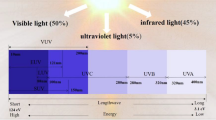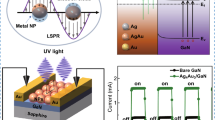Abstract
Infrared absorbance and visible/near-IR excited plasmon resonances are investigated in gold-black, a porous nano-structured conducting film. Polymer infusion (for hardening) generally reduced absorbance in the long wave IR but has little effect at THz wavelengths. The characteristic length scales of the structured films vary considerably as a function of deposition parameters, but the absorbance is found to be only weakly correlated with these distributions. Initial investigations of gold-black by photoelectron emission microscopy (PEEM) reveal plasmon resonances, which have potential to enhance the efficiency of thin film solar cells. For films with different characteristic length scales, the plasmon resonances appear in structures with similar length scales.
Similar content being viewed by others
References
C. Doland, P. O’Neill, and A. Ignatiev, “Particulate nature of solar absorbing films: Gold black,” J. Vac. Sci. Tech. 14 (1), 259–262, (1977).
P. O’Neill, C. Doland, and A. Ignatiev, “Structural composition and optical properties of solar blacks: gold black,” Applied Optics 16 (11), 2822–2826, (1977).
N. Nelms and J. Dowson, “Goldblack coating for thermal infrared detectors,” Sensors and Actuators A. 120, 403–407, (2005).
A. H. Pfund, “The Optical Properties of Metallic and Crystalline Powders,” J.O.S.A. 23, 375–378, (1933).
L. Harris, R. T. McGinnies, and B. M. Siegel, “The Preparation and Optical Properties of Gold Blacks,” J. Opt. Soc. Am. 38 (7), 582–589, (1948).
L. Harris and J. K. Beasley, “The Infrared Properties of Gold Smoke Deposits,” J. Opt. Soc. Am. 42 (2), 134–140, (1952).
L. Harris and A. L. Loeb, “Conductance and Relaxation Time of Electrons in Gold Blacks from Transmission and Reflection Measurements in the Far Infrared,” J. Opt. Soc. Am. 43 (11), 1114–1118, (1953).
L. Harris, “The Transmittance and Reflectance of Gold Black Deposits in the 15- to 100-Micron Region,” J. Opt. Soc. Am. 51 (1), 80–82, (1961).
L. Harris and P. Fowler, “Absorptance of Gold in the Far Infrared, J. Opt. Soc. Am. 51 (2), 164–167, (1961).
W. Becker, R. Fettig, and W. Ruppel, “Optical and electrical properties of black gold layers in the far infrared,” Infrared Phys. & Tech. 40, 431–445, (1999).
H. R. Stuart D. G. Hall, “Island size effects in nanoparticles-enhanced photodetectors,” App. Phys. Lett. 73 (26), 3815–3817 (1998).
K. R. Catchpole, S. Pillai, “Absorption enhancement due to scattering by dipoles into silicon waveguides,” J. Appl. Phys. 100 (4), 044504 (2006).
G. Foster, “Wavelets for period analysis of unevenly sampled time series” Astron. J. 112, 1709–1729 (1996).
C. Torrence, G. P. Compo, “A practical guide to wavelet analysis,” Bull. Amer. Met. Soc. 79, 61–78 (1998).
Author information
Authors and Affiliations
Rights and permissions
About this article
Cite this article
Peale, R.E., Cleary, J.W., Ishigami, M. et al. Gold-black as IR absorber and solar cell enhancer. MRS Online Proceedings Library 1208, 2104 (2009). https://doi.org/10.1557/PROC-1208-O21-04
Received:
Accepted:
Published:
DOI: https://doi.org/10.1557/PROC-1208-O21-04




